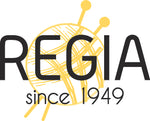15/11/2022
Knitting for Premature babies
Premature babies are babies that come into the world before the end of the 37th week of pregnancy. (Normally, pregnancy lasts about 40 weeks). Premature babies are not only smaller and generally more immature than babies born later, they also have a particularly sensitive skin. Therefore, if you want to knit for premature babies, there are a number of things you need to consider.
The perfect yarn
When knitting for the little ones, special hygiene rules must be observed: Yarns must be lint-free, because flying fibers could interfere with breathing, and that can be life-threatening to a premature baby's still immature lungs. The yarn must also be hot-washable, free of chemicals and harmful substances, and able to withstand disinfection. Therefore, cotton yarns such as those of the Schachenmayr Catania family, yarns of the Baby Smiles collection but also the classic REGIA 4-ply are well suited. All the yarns mentioned have OekoTex certification (Standard 100), which means that they have been tested for harmful substances and are harmless to health.
The perfect yarn
The skin of premature babies is extremely thin (depending on the degree of maturity). Sometimes even "skin on skin" leaves an imprint. Therefore, it is very important that everything you knit for a premature baby has no texture or relief patterns. Sometimes even a garment knitted in garter stitch is too much of a good thing. This must also be taken into account for the cast-on and cuffs. A general recommendation is to knit the cast-on with needles that are one size thicker than the ones you'd normally use - even if you would prefer a firmer stitch pattern.
The perfect finish
Generally speaking: the simpler the better. Therefore, please refrain from buttons, bows, rivets or the like, because all of this would leave pressure marks. But also stranded knitting, where floats are carried on the inside of the garment, are not recommended. They are difficult to put on, moreover, small fingers can get caught within.
The perfect design
Since most of a premature baby's heat loss occurs from the surface of the head or their tiny feet, wearing socks and hats is essential and in great demand in clinics.
When knitting a hat, make sure that the cast-on is soft, and knit a 2x2 ribbing (knit 2 stitches, purl 2 stitches) throughout. This way, the hat will "grow" with the child. With the smallest ones, the lower edge is folded over (so that the cast-on edge does not lie directly on the skin), and as the premature baby grows, the fold becomes smaller. If you are knitting with REGIA 4-ply, cast on approx. 88 stitches for a hat and start decreasing after at least 15 cm.
For socks, the cast-on and leg (best knitted in 2x2 ribbing) must also be very soft. The foot length should be at least 9 cm, even if the baby feet are much smaller. Probes, cables and fixation bandages need space as well as the fingers of the caregivers (who check the correct fit of all this). Please take this into consideration. A row of holes at the transition from leg to foot, through which a ribbon is put, is helpful - because wide socks have less support. Please make sure the ribbon is long enough to be tied. REGIA 4-ply socks are best started with 32 or 36 stitches on the leg using 2.5 mm needles (or bigger). All other specifications can be found in our sock tutorial R0333.
Many thanks to Petra Haas, who has led the non-profit association "Stricken für Frühchen e.V." for more than 15 years and has provided a great number of hospitals with thousands of knitted pieces for premature babies over the years. A heartfelt thank you for the valuable tips she shared with all of us and for her honorable commitment, which her family always supported during this time. Many hardworking helpers have supported Ms. Haas with the preemie initiative.
